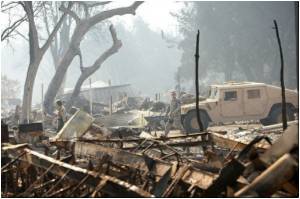Satellite images, air quality measurements and smoke forecasting models are handy to alert individuals and public health professionals to plan for smoke events at areas prone to forest fire smoke.

N.B. Brauer is participating in an AAAS press briefing at 2pm PST, Feb. 18 at the Vancouver Convention Centre Room 223-224. He is available for telephone interviews after the press briefing. Please contact Katherine Came at 604.219.0185.
Brauer's seminar, titled Fires, Smoke, and Health: Impacts and Prevention, is at 8:30-11:30 a.m. Feb. 19 in Room 109 at the Vancouver Convention Centre.
Vegetation fire frequency and intensity are expected to increase as a consequence of climate change, according to Brauer. While there are other potentially harmful pollutants in fire smoke, increases in fine particulate matter are of most concern. Particulate matter can remain suspended in the air for days, or even weeks, affecting air quality across large regions. These particles are fine enough to easily penetrate indoor environments.
Brauer and colleagues at the BC Centre for Disease Control have conducted a number of studies to demonstrate that particles from forest fires pose an increased risk to public health, causing a wide range of respiratory health effects . Their current work, with graduate student Jiayun Yao, evaluates the ability of smoke forecasting tools such as the BlueSky Western Canada Wildfire Smoke Forecasting System to predict health impacts.
"Given the health effects related to fire smoke exposure and the likelihood of increased fire smoke episodes resulting from climate change, strategies to mitigate the public health impacts are required," says Brauer, a professor in the School of Population and Public Health at UBC and co-lead of the School's Occupational and Environmental Health theme. "Smoke forecasting tools can help individuals and public health professionals prepare for smoke episodes."
Advertisement
"Individuals with pre-existing heart and lung conditions need to limit their exposure to fire smoke and to also ensure they have adequate supplies of reliever medications when the fire season begins."
Advertisement













